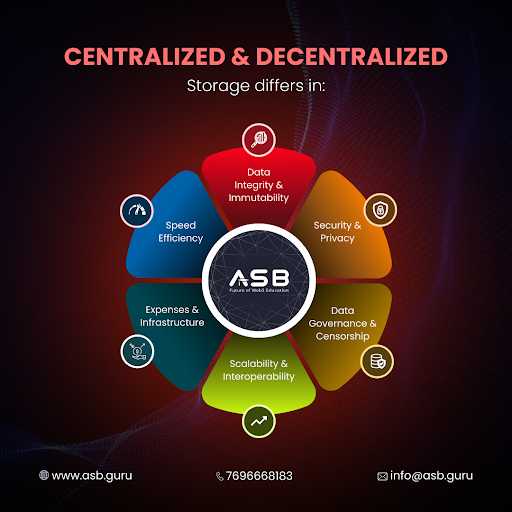Resolving the Storage Dilemma:Centralized vs Decentralized Systems
With the growing digital connectivity across the globe, there is an increasing need for secure and robust data storage solutions. Generally, individuals and organizations opted for centralized storage offered by leading cloud service providers like Amazon, Google, and Microsoft. However, since the launch of blockchain technology, a decentralized way of securing data has surfaced and is also, gaining acceptance due to its many benefits.
While both types of storage systems have their share of advantages and limitations, it is a crucial and necessary decision to make.
Here, we uncover the key differences in the concepts, working, technology, and future scope of centralized and decentralized storage solutions.
The Concepts of Centralization and Decentralization
The world has progressed from storing data offline in devices like hard disks to uploading and managing it online with cloud services. Such an evolution has been mainly propelled by the internet. Nowadays, we don’t have to go through the laborious procedures of copying and accessing data, as everything is available anywhere and anytime with a few clicks of a smartphone.
As the internet is moving from web2 to web3, the innovative blockchain technologies have opened up a network of decentralized storage options.
Considering the ambiguities around the use of decentralized platforms, the trend started with organizations utilizing blockchain tech for centralized storage, before adapting to the decentralized approach. Yet, today, decentralized storage solutions cost 78.6% less than centralized ones.
In a centralized storage system, the complete data is kept in one designated location, usually a server. Users can access or download this data from a common repository via a network, like the Internet. Every dimension of data storage, including its arrangement, backup, and accessibility, is tackled by a central server, which is managed by an authority.
Popular centralized cloud storage platforms are Google Drive, Microsoft OneDrive, Azure, Amazon Web Services (AWP), Dropbox, etc.
On the other hand, decentralized data systems, supported by web3 storage platforms, spread data across a number of nodes or devices without the need for any single central server. This sort of distributed ecosystem is made possible by blockchain technology, where data is encrypted by advanced cryptographic techniques.
BitTorrent (BTFS), Filecoin, and Utopia are some of the well-known decentralized alternatives for data storage and management.
Centralized vs Decentralized Storage: What set them apart?
Since the foundational concepts of both centralized and decentralized systems are quite different, there are evident dissimilarities in aspects like data control, security, privacy, governance, availability, costs, accessibility, speed, scalability, etc. As the volume of data rises, its storage becomes a primary concern for people and organizations worldwide
Here’s a detailed review of the differences between centralized and decentralized data storage ecosystems:

Data Integrity and Immutability
In the case of a centralized server, the onus of data consistency relies upon the authority responsible for its management. This not only makes it prone to human errors and technical failures but also highly dependent on network standards, as a single body or device handles an enormous amount of data.
However, the decentralized databases are present on the blockchain, which ensures their inherent tamperproof and immutable characteristics. The chosen blockchain network may be private or public, yet the data once recorded stays permanent. So, the decentralized structures exhibit greater fault tolerance and resilience than their centralized counterparts.
Security and Privacy
It is clearly more difficult for unauthorized parties to access or alter data on decentralized data storage systems, as it is encrypted and dispersed over numerous nodes. In other words, the improbability of a single point of failure keeps decentralized data secure.
But, the centralized servers, albeit the encrypted security measures, are much more vulnerable as everything is hosted on one single server location. This limitation in centralized storage can result in the leak of sensitive data, financial losses, identity thefts, and other frauds. Besides, the accessibility and availability of the data are also hampered if the centralized server crashes or goes downtime.
Data Governance and Censorship
In a centralized architecture, data control and governance are solely exercised by a single person or organization. This central authority establishes data policies and decides its accessibility levels, protection protocols, retrieval, and modifications. Contrastingly, a decentralized framework gives authority and management to a whole network of nodes. Each of the network participants has ownership of their data, including encryption keys and access permissions. Further, several types of consensus mechanisms are followed for collective decisions regarding data management, visibility, security, and governance.
Speed Efficiency
When it comes adding data or processing information to a centralized server, the speeds lie in a certain predictable range. But for decentralized ecosystem, this depends on a number of factors like the blockchain network, complexity of protocols, network traffic, etc.
Considering that for any block of data to be added onto blockchain, there is a need to build consensus among all distributed nodes, decentralized systems are likely to take longer.
Expenses and Infrastructure
As indicated before, decentralized storage solutions cost less than their centralized ones. This is generally because the infrastructural expenses involved in upgrading centralized servers are much higher. Though the earliest decentralized networks utilized heavy resources in terms of energy and computations, today, they are capable of being updated at minimal costs.
Scalability and Interoperability
This is one of the major challenges faced by centralized servers as there is an increase in user demands and data quantities. While decentralized platforms are more cost-effective in this respect, there are still a few protocol-agnostic networks which makes interoperability still a hurdle in their wide-scale adoption.
Regulatory Landscape and Legal Compliance
For the centralized data storage sector, there are standard international as well as national laws like GDPR, FedRamp, etc.
But, the regulatory environment around decentralized ecosystems is still in the developing phase, with differing levels of development and transparency in various nations. With some countries like the US, Japan, Singapore, etc, having set the proper regulatory laws for decentralized data solutions, others like the UK, India, and EU, are still contemplating opening up to the latest storage technology.
On the other hand, some of the nations like China and Russia are reluctant to adapt to the decentralized arena.
Future of Storage Solutions
In the present data-driven world, it is incumbent for enterprises to make crucial decisions as to how to store and manage their confidential data assets. While the debate around centralization versus decentralization continues, we can infer that the latter will benefit users worldwide, bringing in more inclusivity its trustless and permissionless methodologies.
It would be more just a matter of time till the geographical restrictions are eliminated and global regulations put forth, for the standardization of the decentralized domains. With further advancements, more delegated consensus mechanisms and layer-2 solutions will emerge, thus rectifying performance issues and making storage solutions convenient for one and all.
